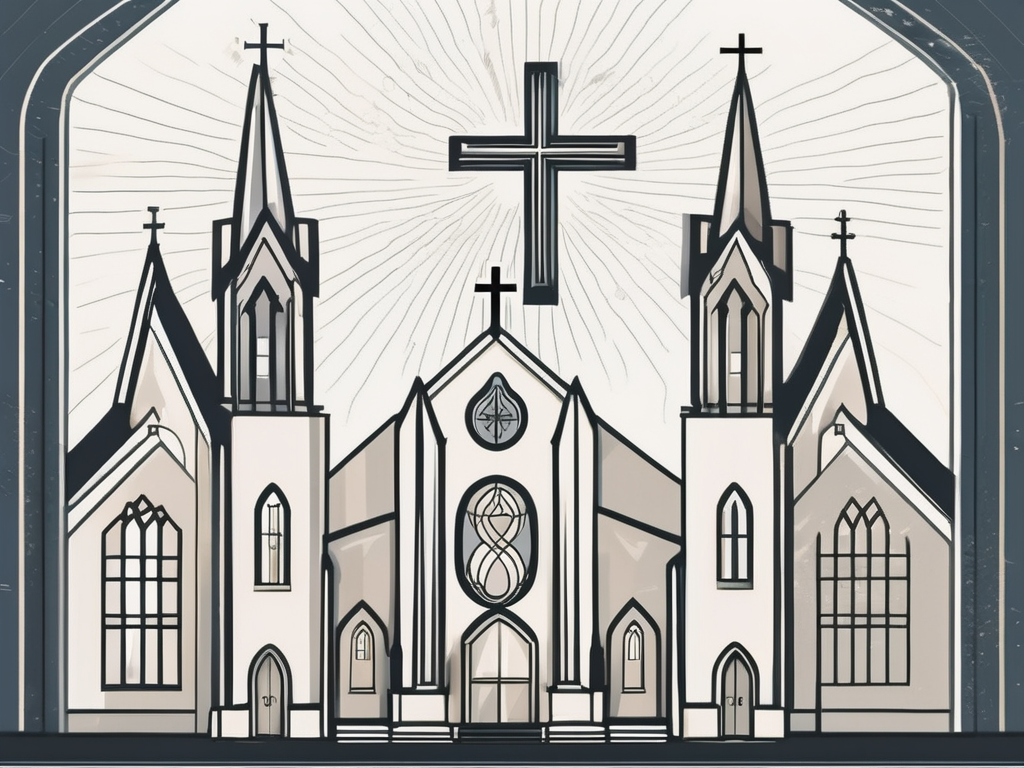Are you curious about the differences between Catholicism and Lutheranism? In this article, we will delve into the key aspects that set these two Christian religions apart. Understanding the basic beliefs, the role of the Bible, the concept of salvation, the sacraments, and the structure of church hierarchy will help us grasp the divergences and similarities between Catholicism and Lutheranism. So, let’s dive in!
Understanding the Basic Beliefs
Catholicism and Lutheranism, while sharing a common foundation in Christianity, differ in their interpretations of certain core beliefs. Let’s explore these beliefs in more detail.
Core Beliefs of Catholicism
Catholicism places a strong emphasis on the authority of the Pope and the magisterium, or the teaching authority of the Church. The Pope, as the successor of Saint Peter, is believed to be the vicar of Christ on Earth, entrusted with the responsibility of guiding the Church and interpreting the teachings of Jesus. The magisterium, consisting of the Pope and the bishops, is seen as the authoritative voice in matters of faith and morals.
In addition to the authority of the Pope and the magisterium, Catholics believe in the concept of transubstantiation. This is the belief that during the Eucharist, the bread and wine used in the sacrament become the literal body and blood of Christ. This belief is rooted in the words of Jesus at the Last Supper, where he said, “This is my body” and “This is my blood.”
Catholics also venerate saints, considering them as holy men and women who have lived exemplary lives of faith. They believe that saints can intercede on their behalf and pray for them. This practice is based on the belief in the communion of saints, which is the spiritual connection between the members of the Church on Earth, in Heaven, and in Purgatory.
Furthermore, Catholicism embraces the use of statues and images in worship. These visual representations are not seen as idols to be worshipped, but rather as aids to devotion and reminders of the presence of God and the saints. Catholics believe that these images can help them focus their prayers and deepen their connection with the divine.
Lastly, Catholicism acknowledges the importance of rituals and sacraments. The seven sacraments, including baptism, confirmation, Eucharist, reconciliation, anointing of the sick, holy orders, and matrimony, are considered essential channels of God’s grace. These rituals are seen as outward signs of inward grace, through which believers can encounter God and receive spiritual nourishment.
Fundamental Beliefs of Lutheranism
Lutheranism, on the other hand, emphasizes the doctrine of justification by faith alone. Lutherans believe that individuals are saved solely through their faith in Jesus Christ and not by their own works. This belief is rooted in the teachings of Martin Luther, the founder of Lutheranism, who challenged the Catholic Church’s practice of selling indulgences and emphasized the importance of faith as the means of salvation.
Lutherans hold that religious authority is based on Scripture alone, rejecting the primacy of the Pope. They believe that the Bible is the ultimate authority in matters of faith and practice, and that it should be accessible to all believers. This belief led to the translation of the Bible into vernacular languages and the promotion of literacy among the laity.
In contrast to Catholicism, Lutheranism permits a more simplified approach to worship. While Lutherans still value the sacraments, they place less emphasis on rituals and ceremonial practices. The focus is more on the preaching of the Word of God and the proclamation of the Gospel. Lutherans believe that through the hearing of the Word and the receiving of the sacraments, believers can experience the presence of Christ and receive His grace.
It is important to note that while there are differences in beliefs and practices between Catholicism and Lutheranism, both traditions share a common commitment to the central tenets of Christianity, such as the belief in the Trinity, the divinity of Jesus Christ, and the importance of love, compassion, and service to others.
The Role of the Bible in Both Religions
The Catholic Church and Lutherans approach the Bible differently, shaping their religious practices and beliefs.
The Catholic Perspective on the Bible
Catholicism reveres the Bible and views it as a sacred text inspired by God. The Church, however, also acknowledges the importance of tradition in interpreting Scripture. The Catholic approach emphasizes the need for proper theological interpretation, recognizing the Pope’s authority in clarifying doctrinal matters.
Within the Catholic Church, the Bible holds a central role in liturgical practices. During Mass, the priest reads passages from the Old and New Testaments, connecting the congregation to the teachings and stories of the Bible. The readings are carefully selected to align with the liturgical calendar, providing a thematic link to the celebration or commemoration of a specific event or saint.
Furthermore, Catholicism places great emphasis on the sacraments, which are seen as channels of God’s grace. The Bible serves as a foundation for understanding and participating in these sacraments. For example, the sacrament of baptism is rooted in the biblical accounts of Jesus’ own baptism and his command to his disciples to baptize others in the name of the Father, Son, and Holy Spirit.
Another significant aspect of the Catholic approach to the Bible is the use of commentaries and exegesis. Catholic scholars and theologians delve deep into the Scriptures, seeking to uncover the historical, cultural, and theological contexts in which the texts were written. This scholarly exploration helps to shed light on the intended meaning of the biblical passages and aids in the formation of Catholic doctrine and teachings.
The Lutheran View of the Bible
Lutherans adhere to the principle of Sola Scriptura, meaning “Scripture alone.” They believe that the Bible, as the inspired word of God, is the ultimate authority in matters of faith and practice. Lutherans encourage personal interpretation and understanding of the Bible, empowering individuals to develop their relationship with God through heartfelt study of the Scriptures.
In Lutheran worship, the Bible holds a central position. The liturgy often includes readings from both the Old and New Testaments, providing a comprehensive view of God’s revelation throughout history. These readings are carefully selected to align with the theme of the worship service, reinforcing the message being conveyed to the congregation.
One distinctive feature of the Lutheran approach to the Bible is the concept of “Law and Gospel.” Lutherans believe that the Bible contains both the Law, which reveals our sinfulness and the need for God’s grace, and the Gospel, which proclaims God’s forgiveness and salvation through Jesus Christ. This understanding shapes their interpretation of the Scriptures and influences their preaching and teaching.
Lutherans also value the importance of education and study in relation to the Bible. They encourage individuals to engage in personal Bible study, often providing resources and study materials to aid in this process. Additionally, Lutherans place a strong emphasis on the role of the pastor as a teacher, responsible for guiding and equipping the congregation in their understanding of the Scriptures.
Furthermore, Lutherans recognize the historical context in which the Bible was written and seek to understand the original intent of the biblical authors. They utilize various tools and methods of biblical interpretation, such as historical-critical analysis and contextual reading, to gain a deeper understanding of the text. This approach helps to ensure that the teachings and practices of the Lutheran Church are firmly grounded in the biblical message.
The Concept of Salvation
Salvation, a central tenet of Christianity, is understood differently in Catholicism and Lutheranism. It is a topic that has been debated and discussed for centuries, with each denomination offering its own unique perspective.
Salvation According to Catholicism
Catholicism, one of the oldest Christian denominations, believes in a multifaceted approach to salvation. Catholics view salvation as a lifelong process, a journey that involves both faith and good works. They emphasize the need for sacraments, such as baptism and confession, as channels of God’s grace. These sacraments are seen as essential for receiving and maintaining salvation.
Furthermore, Catholics uphold the significance of purgatory, a state of purification before entering heaven. They believe that after death, those who have died in a state of grace but still have imperfections and sins are cleansed in purgatory. This purification process is seen as necessary for the soul to be fully prepared for the glory of heaven.
Within Catholicism, salvation is not seen as a one-time event but rather as an ongoing journey of transformation and growth in holiness. It is a process that requires continuous effort and commitment to living a life in accordance with God’s teachings.
Lutheran Interpretation of Salvation
Lutheranism, a Protestant denomination that emerged during the Reformation, offers a different perspective on salvation. Lutherans adhere to the doctrine of justification by faith alone, which asserts that salvation is granted solely through faith in Jesus Christ. They believe that salvation is a gift from God, received by grace through faith.
According to Lutherans, good works are a natural outflow of faith but are not a means to salvation. They emphasize that salvation is entirely the result of God’s grace and the individual’s trust in Christ as their savior. Lutherans believe that humans are incapable of earning or deserving salvation through their own efforts.
For Lutherans, salvation is a momentous event that occurs when an individual places their trust in Christ and accepts His sacrifice on the cross as the means of their redemption. This act of faith is seen as the key that unlocks the door to eternal life.
While Lutherans acknowledge the importance of living a life that reflects the teachings of Christ, they do not see good works as a requirement for salvation. Instead, they view good works as a natural response to God’s love and grace, flowing from a heart transformed by faith.
Both Catholicism and Lutheranism offer rich and nuanced understandings of salvation. While they may differ in certain aspects, both emphasize the central role of Jesus Christ in the process of salvation and the need for a personal relationship with Him. The concept of salvation continues to be a source of contemplation and exploration for believers in both traditions, as they seek to deepen their understanding and experience of God’s saving grace.
The Sacraments and Their Significance
The use and significance of sacraments differ between Catholicism and Lutheranism. Let’s explore these differences in more detail.
The Seven Sacraments in Catholicism
Catholicism recognizes seven sacraments: baptism, confirmation, Holy Eucharist, penance, anointing of the sick, holy orders, and matrimony. These sacraments are seen as visible signs of God’s grace, imparting spiritual blessings to believers. Each sacrament holds a unique role in the life of a Catholic, providing channels through which they experience God’s presence and grace.
Baptism: This sacrament is the first step in a Catholic’s spiritual journey. Through baptism, individuals are cleansed of original sin and welcomed into the Christian community. It is a moment of rebirth and initiation into the Church.
Confirmation: Following baptism, Catholics receive the sacrament of confirmation. This sacrament strengthens their faith and deepens their connection to the Holy Spirit. It is a personal affirmation of their commitment to the Catholic Church.
Holy Eucharist: Also known as the sacrament of the Holy Communion, this is the central sacrament of Catholicism. During Mass, bread and wine are consecrated and believed to become the body and blood of Christ. Catholics partake in the Eucharist to receive spiritual nourishment and unite with Christ.
Penance: This sacrament, also called confession or reconciliation, allows Catholics to seek forgiveness for their sins. Through confession to a priest, they receive absolution and are reconciled with God and the Church.
Anointing of the Sick: This sacrament is administered to those who are seriously ill or approaching death. Through anointing with holy oil and prayer, Catholics seek God’s healing and strength in times of physical and spiritual suffering.
Holy Orders: This sacrament is reserved for those called to serve the Church as priests or deacons. Through the laying on of hands by a bishop, individuals are ordained and receive the authority to administer sacraments and lead the faithful.
Matrimony: The sacrament of matrimony is a sacred union between a man and a woman. Through their vows, they commit to a lifelong partnership, blessed by God and witnessed by the Church.
The Two Sacraments in Lutheranism
Lutheranism, inspired by the teachings of Martin Luther, recognizes two sacraments: baptism and Holy Communion. Lutherans view these sacraments as means of grace, sacraments of the gospel, through which God’s grace is conveyed to believers. They consider baptism as the gateway to the Christian life and Holy Communion as a sacred remembrance of Christ’s sacrifice.
Baptism: Similar to Catholicism, Lutherans believe that baptism is a sacrament of initiation. It is through baptism that individuals are welcomed into the Christian community and receive God’s grace. Lutherans also believe that baptism is a visible sign of God’s promise of salvation.
Holy Communion: Lutherans hold the sacrament of Holy Communion in high regard. They believe that, during the Eucharist, the bread and wine are not transformed into the literal body and blood of Christ, but that Christ is truly present in, with, and under the elements. Through partaking in Holy Communion, Lutherans receive spiritual nourishment and are reminded of Christ’s sacrifice for their salvation.
While Catholicism recognizes more sacraments than Lutheranism, both traditions emphasize the importance of these sacred rituals in the spiritual journey of believers. The sacraments serve as visible signs of God’s grace and provide a means for believers to experience God’s presence in their lives.
The Structure of Church Hierarchy
The organizational structure of the Catholic Church and the Lutheran Church differ in terms of authority and governance.
The Hierarchical Structure of the Catholic Church
The Catholic Church has a hierarchical structure led by the Pope, who is considered the Vicar of Christ on earth. Beneath the Pope are Cardinals, Bishops, and Priests. The Pope holds the ultimate authority and is responsible for guiding the Church’s doctrines and decisions.
The Organizational Structure of the Lutheran Church
The Lutheran Church operates on a more congregational-based structure. Each local congregation has some level of autonomy and can make decisions regarding matters of worship, doctrine, and governance. Lutherans tend to emphasize the importance of local leadership and democratic processes within the Church.
In conclusion, Catholicism and Lutheranism share a common foundation in Christianity but diverge on several theological aspects. Understanding the basic beliefs, the role of the Bible, the concept of salvation, the sacraments, and the structure of church hierarchy provides insights into the distinctive features of these two important Christian traditions. By appreciating these differences, we can foster a greater understanding and respect for the rich tapestry of Christian faith.












